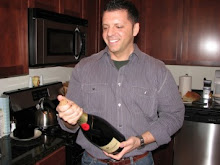 A couple years back (wow time flies), Christine and I went on our honeymoon to Paris. We were really looking forward to the unique wine experiences that lay ahead. We had two really terrific experiences surrounding wine. We had a chance to take a quick trip outside of Paris to the Champagne Region (only an hour and a half drive). While there we had a chance to tour the property of the famed Moët & Chandon, as well as Chateau de Castellane in Epernay. Both were tasty (we got to drink bubbles) and informative. An equally informative and pleasant wine experience took place on Day One, in Paris!
A couple years back (wow time flies), Christine and I went on our honeymoon to Paris. We were really looking forward to the unique wine experiences that lay ahead. We had two really terrific experiences surrounding wine. We had a chance to take a quick trip outside of Paris to the Champagne Region (only an hour and a half drive). While there we had a chance to tour the property of the famed Moët & Chandon, as well as Chateau de Castellane in Epernay. Both were tasty (we got to drink bubbles) and informative. An equally informative and pleasant wine experience took place on Day One, in Paris!Our Parisian Honeymoon began with a wine tasting. We thought we would take the opportunity to get to know Paris and walk to our destination (it looked like only six inches on the map so how far could it be?!). We walked from the Arc de Triomphe to the extreme opposite side of old Paris. Let’s just say that the blisters were a constant reminder that better planning would have been helpful! Regardless, we made it to our destination and quite frankly, it was awesome!
 Oliver Magny runs Ô Chateau, which at the time was run out of his loft. It was such a cool, hip place and offered a very relaxing atmosphere to begin your journey across Frances different wine regions. Christine and I ended up doing the "Grand 7" tasting. Think of the Tour de France, traveling all around but instead of riding a bike you are drinking wine, without leaving the room. We tasted wines from the Champagne, Loire Valley, Burgundy, Bordeaux, Languedoc, the Rhône Valley, and Alsace regions. It was a cool progression that showed the diversity of France’s wines. The whole time Olivier's passion and knowledge for wine came through in such an inspiring and easy to understand way (the best way to describe Olivier is to think of Jamie Oliver, but for wine and without a lisp). Also, if I remember correctly, this is the moment marking the transition for Christine from fruity whites towards the reds! That would make Olivier my hero!
Oliver Magny runs Ô Chateau, which at the time was run out of his loft. It was such a cool, hip place and offered a very relaxing atmosphere to begin your journey across Frances different wine regions. Christine and I ended up doing the "Grand 7" tasting. Think of the Tour de France, traveling all around but instead of riding a bike you are drinking wine, without leaving the room. We tasted wines from the Champagne, Loire Valley, Burgundy, Bordeaux, Languedoc, the Rhône Valley, and Alsace regions. It was a cool progression that showed the diversity of France’s wines. The whole time Olivier's passion and knowledge for wine came through in such an inspiring and easy to understand way (the best way to describe Olivier is to think of Jamie Oliver, but for wine and without a lisp). Also, if I remember correctly, this is the moment marking the transition for Christine from fruity whites towards the reds! That would make Olivier my hero! The reasons I wanted to write about Ô Chateau is that if you ever go to Paris, you better include this experience in your trip. It is a great way to jump-start your Parisian vacation, while truly enjoying some nice wines and company. The second reason is to recommend that you remain open to the expertise and enthusiasm of professionals in the wine world. Be it your local wine shop owner or the tasting-room person in any Napa winery, we all love to share our wine knowledge. If you have questions, please never hesitate to ask! To us, there is nothing better.
The reasons I wanted to write about Ô Chateau is that if you ever go to Paris, you better include this experience in your trip. It is a great way to jump-start your Parisian vacation, while truly enjoying some nice wines and company. The second reason is to recommend that you remain open to the expertise and enthusiasm of professionals in the wine world. Be it your local wine shop owner or the tasting-room person in any Napa winery, we all love to share our wine knowledge. If you have questions, please never hesitate to ask! To us, there is nothing better.** Note** Ô Chateau is now located under the historic and beautiful Parisian Hotel Particulier. The tasting room is the 300 year old cellar that served as the personal cellar of King Louis XV’s sommelier!
For more info on Ô Chateau please visit their website (http://www.o-chateau.com/).







